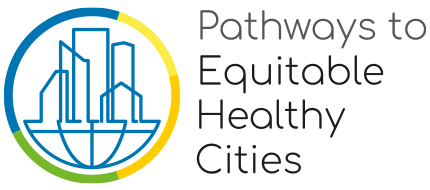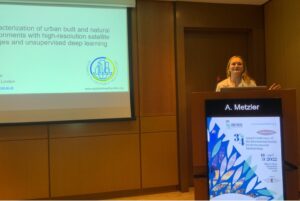This year, Pathways members Barbara Metzler (PhD student) and Sierra Clark (former PhD student) travelled to Athens to attend and present their research at the Conference of the International Society for Environmental Epidemiology (ISEE, September 18th – 21st 2022), which is the largest gathering of environmental epidemiologists each year. After two years of being held virtually due to COVID-19, about 1,200 researchers were able to gather and engage in person with the latest developments in the field. The conference also kept virtual engagement through online component and apps for researchers that preferred, or could not attend in person.
The conference covered a variety of topics related to the ways in which our environments (e.g., outdoor, home, or school environment) and what we are exposed to in them (e.g., air pollution, noise) can impact our health, and what this means for policy and practice. This year, there was a large focus on outdoor air pollution exposures and health impacts. Some other topics also had quite a bit of attention, including environmental exposures in early childhood, climate change, and measurement error. As well, an emerging field called the ‘Exposome’, which is the study of the cumulation of exposures we experience throughout our lifetime, also had a big focus at the conference.

Barbara & Sierra, along with some conference colleagues, soak up a bit of Greek history at the Acropolis before the conference commences
Both Barbara and Sierra presented on their Pathways PhD work in the West African city of Accra (Ghana), which covered machine learning, satellite imagery, and environmental noise exposure measurement and modelling. Here are some reflections on their experiences:
Barbara at ISEE
I was very excited to be given the opportunity of an oral presentation at ISEE, where I could showcase parts of my PhD research during the session on “Environment and health in low and medium-income areas”. After attending various virtual conferences and workshops as part of my PhD, I was particularly thrilled to get to meet young as well as established researchers in person and discuss common research interests.
My presentation focused on the clustering framework I developed to characterise urban built and natural environments with very high-resolution satellite images and unsupervised deep learning. As part of the framework, I identified eight different clusters of the urban fabric of Accra, Ghana. These clusters range from a cluster that picks up very densely populated areas that are scattered throughout the city to a cluster that picks up dark dense vegetation (mostly capturing the forest in the north of the city), and a range of other clusters that lie in between. The method can be used as a cost-effective interpretable and scalable approach for real-time tracking of the urban environment, especially in settings where demographic and environmental data is not frequently updated. The approach has multiple urban environmental applications, such as providing ground data for tracking and measuring urban health, air- and noise pollution, urban connectivity and road traffic, as well as city growth in cities across Africa and beyond.
Next to other presentations from researchers, the session also included an ethics discussion, which was organized and led by the ISEE Ethics and Philosophy Committee. The discussion was centered around the importance of not participating in helicopter (or parachute) research in low and medium-income areas. The discussion was very engaging with thoughtful comments from the audience and the session chairs, such as always considering if a research approach is ethical. Also, in cases where data is openly available, to emphasize potential conflicts of interest from funding institutions and companies. The stimulating discussions highlighted for me once again the importance of collaboration on eye level, which is key to successful research partnerships and ultimately creating valuable research.
Sierra at ISEE
 I finished my PhD with Pathways in March 2022, and was thus delighted to present some of the final results from my 3 ½ year journey at the conference. At previous conferences, I had presented bits and pieces of my PhD, and now I was finally able to present it as one cohesive story!
I finished my PhD with Pathways in March 2022, and was thus delighted to present some of the final results from my 3 ½ year journey at the conference. At previous conferences, I had presented bits and pieces of my PhD, and now I was finally able to present it as one cohesive story!
In addition to engaging with many interested conference attendees at my poster, I also gave a presentation in a dedicated session on ‘Environmental Health in LMICs’. My presentation was on measuring and modelling noise pollution in Accra and estimating the associated health impacts. I talked about how myself and the Pathways team designed and carried out noise measurements across the city, which was the longest (1 year) and largest (146 locations) effort of its kind in sub-Saharan Africa. I then used this rich dataset to model noise exposures and the presence of different types of sounds across the city. There were many take aways and lessons learned from my work. Perhaps some of the most important were that the majority of city residents live in areas where noise exposures surpass World Health Organisation health-based guidelines. These guidelines are based on noise from road-traffic. As well, while noise levels in the city are generally quite elevated everywhere, some neighbourhoods are worse off than others. On average the poorest neighbourhoods have the highest noise exposures as well as estimated health impacts relating to being annoyed and sleep disturbed.
I also discussed with conference attendees how my modelled noise exposures can be used to further understand the health impacts of noise in Accra and sub-Saharan Africa. This is important, as much of the evidence of noise health impacts, whether due to sleep disturbance, mental health, or cardiometabolic diseases, are from studies conducted in Europe (and even more specifically Western Europe). Conducting high-quality epidemiological studies in sub-Saharan Africa will be essential to diversifying the global evidence on the health impacts of noise, which may vary in different socio-economic and cultural contexts. The Pathways team will be looking into these potential health impacts in Accra in the coming years among school aged children, pregnant mothers and new-born babies (Projects led by Dr. Raphael Arku)

